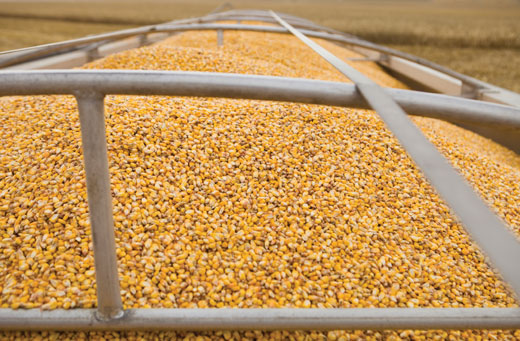Nebraska Harvest Wraps Up in Record Fashion

As farmers across the Cornhusker State park their harvesting equipment for the winter, many are feeling the satisfaction of reaping a bountiful harvest. According to the USDA’s National Agricultural Statistics Service (NASS) data for November 1st conditions, Nebraska boasted a record high 1.68 billion bushels, up 4 percent from last year. The area harvested for corn was 9.00 million acres, also up a percentage point. Likewise, the average yield forecast is at a record high 187 bushels per acre, up 8 bushels per acre from 2014.
Nationally, the corn production forecast was up only slightly from October estimates, at 13.7 billion bushels. However, this number is also down 4 percent from last year’s record corn production. Based on November 1st conditions, NASS data showed that the national yield average stands at 169.3 bushels per acre, up from last month, but down 1.7 bushels from the 2014 average.
Still, if the 13.7 billion bushel estimate is realized, it will represent the second highest yield and third largest production on record for the nation.
Nebraska farmers also brought in a mammoth soybean harvest, with a record high forecast of 291 million bushels—1 percent up from last year. Similarly, the record yield forecast stands at 56 bushels per acre, up 2 bushels from 2014.
Nationwide soybean production tells a similar story. Soybean production forecasts are at a record 3.98 billion bushels, up 2 percent from 2014. Nationwide soybean yields are expected to average 48.3 bushels per acre, up 1.1 bushels per acre from last month and up 0.8 bushels from the 2014 harvest.
Of course, record harvests also spell lower commodity prices, and despite doing well in the fields, farmers in the state and across the nation are feeling the pinch of the continued low corn and bean prices. According to the Federal Reserve Banks of Kansas City and St. Louis, farm incomes are falling at a dramatic pace, and farmland values are following suit. After three straight years of record crops and falling commodity prices, this trend isn’t unexpected.
Looking ahead, what is the best plan for farmers facing these current challenges?
According to commodities advisor and broker Al Kluis, there are 5 strategies producers may employ—with varying degrees of success. Writes Kluis:
- Hold it and hope:This worked one year out of the last 10. However, it has been a disaster since 2012. Many farmers in a high-equity position (meaning they don’t have much debt) typically hold it and hope. Farmers with deep pockets and big bins can afford to do this, though that still doesn’t mean they make money doing it.
What about farmers who are leveraged or who have two bad crops in a row? Hold-it-and-hope can be a fatal choice, because hope is not a marketing plan.
- Hold and protect: In other words, hold it all and protect the downside with put options. This strategy would allow you to wait for basis improvement, but it would require you to write out a large check for your futures account. Unfortunately, your farm finances may already be tight. Still, it may be worth considering doing this on 5% to 10% of your corn crop just so you can learn how it works.
- Hedge and wait:Hedge the corn and soybeans out into the spring and summer of 2016 and wait for the basis to improve, particularly if you have the corn and most of your soybeans stored at home. This is something to consider on some of your corn crop because of the large carry in the corn futures market, but it doesn’t make any merchandising sense for soybeans.
You need to treat each crop very differently, depending on your basis, carrying charge in the futures, and your local merchandising alternatives.
- Plan and sell:Put together a scale-up marketing plan using both price and time targets so your crop is sold by mid-July. In this plan, you would make a series of 10% or 20% sales. This type of marketing plan takes more time and effort, but it can also make the farm a lot more money. The farmers who do this are not the hold-it-and-hope type. They are a lot more involved with the grain markets each day. Remember, you are growing money – not crops. Do this on 50% to 80% of your corn and soybean crops.
- Sell and buy calls:Sell it all and buy call options back. This would generate a lot of cash right now and would allow you to make more money if futures go higher later. This only makes sense for the soybeans you have in the grain elevator. The cost of the call option is less than your interest and storage bill of keeping the soybeans at the elevator.
With these strategies in mind, it’s important to have a plan in place.
If you’re concerned about employing marketing strategies for your farming operation, feel free to contact UFARM for a consultation. UFARM offers a full range of Nebraska land management services, including real estate sales, rural property appraisals, consultations and crop insurance. UFARM has operated in Nebraska since the early 1930’s. Contact us today!
Sources consulted: Kluis, Al. “Five Strategies to Consider for the 2015 Crop.” Agriculture.com. Meredith Agrimedia. 18 Nov. 2015. Web. 19 Nov. 2015. “Nebraska Corn, Soybean Harvests to Hit Record Highs.” CropWatch. University of Nebraska-Lincoln. 10 Nov. 2015. Web. 19 Nov. 2015.

